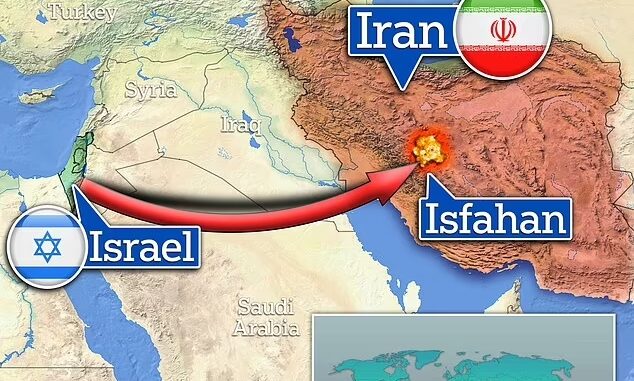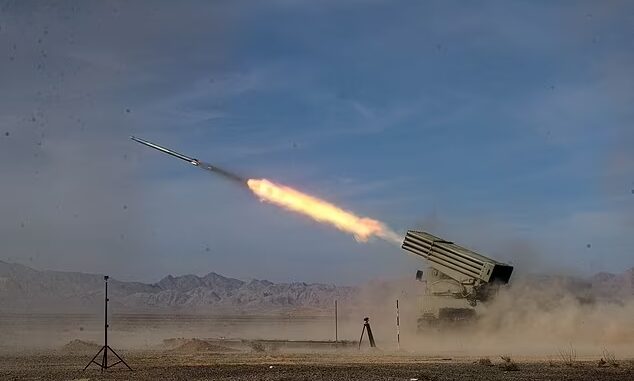Israel’s secret weapon: MARK DUBOWITZ reveals how the Jewish State’s shock strike took out Iran’s air defenses – and did what feckless Biden never could… scare Tehran’s mullahs into silence
By Mark Dubowitz, DAILY MAIL 20 April 2024

Memo to the White House : Time to retire President Biden’s ‘Don’t Doctrine.’ It’s not working.
Mark Dubowitz is chief executive of the Foundation for Defense of Democracies. In 2019, he was sanctioned by Iran for his advocacy.
Memo to the White House: Time to retire President Biden’s ‘Don’t Doctrine.’ It’s not working.
Weeks after an April 1 Israeli airstrike in Syria killed a top Iranian terror general, Biden had one word for Tehran.
‘Don’t,’ he warned, as US intelligence raised the alarm over a retaliatory attack by the Islamic Republic.
But Iran did – launching a 330 missile and armed drone barrage.
The assault on Israel – the first-ever from Iranian territory – was defeated by the combined effort of Israeli air defenses and assistance from the US, UK, France, and Arab allies.

Nevertheless, it was Israel’s turn to punch back. Yet, Biden issued more feckless advice.
‘Take the Win,’ he reportedly urged Israel Prime Minister Benjamin Netanyahu, arguing that Tehran’s failed attack was punishment enough for the regime.
Bibi thought otherwise. Overnight Thursday, Israel launched successful retaliatory strikes targeting a sensitive military site in central Iran.
The fact that the ‘Don’t Doctrine’ is being ignored by enemies and allies alike raises serious concerns over American power and credibility.
But today, Biden should be thanking Israel for teaching him how to play hardball in the Middle East.
For the mullahs have backed down. The Iranians are signaling their desire to stop this escalating conflict – for now.
The Israeli strikes hit near the city of Isfahan, more than 200 miles south of Tehran.
It’s from there that Iran launched some of its swarm of armed drones last week – making Isfahan a legitimate target for reprisal.

The Israeli strikes hit near the city of Isfahan, more than 200 miles south of Tehran/Reuters
Iran’s S-300 Russian-built air defense system, considered one of the most effective in the world, defends the area. But it was rendered useless after Israel took out at least one of its radars.
On Friday, Iran’s foreign minister attempted to downplay the attack.
‘What happened last night was not a strike,’ claimed Hossein Amirbdollahian in a lame attempt to save face. ‘They were more like toys that our children play with – not drones.’
‘We are not going to have any new reactions,’ he concluded.
Translation – Tehran cried uncle.
Isfahan is also the location of Iran’s largest nuclear complex – the Isfahan Nuclear Technology Center.
At Isfahan, Tehran converts yellow cake, a powder obtained through the processing of uranium ore, into uranium hexafluoride, which is the essential precursor for enriched uranium, the material necessary to build a nuclear weapon.
The Isfahan nuclear center also stockpiles some of Tehran’s highly-enriched uranium cache which is now large enough to provide enough weapons-grade material for 12 bombs.
While the strike was an apparent success, the Jewish State did not unleash anything approaching its full capacity. Indeed, Israeli Prime Minister Netanyahu is now being accused of weakness by hardline ministers in his cabinet.
But regardless, the attack sent a clear message to Tehran: We can penetrate your air defenses at will.
Iran appears to have been caught off-guard by this attack, indicating that Israel may have deployed a weapons capability that its enemies — perhaps even the US — were unaware that it possessed.
62 miles north of Isfahan is Natanz, the Islamic Republic’s second main enrichment facility.

Iran appears to have been caught off-guard by this attack, indicating that Israel may have deployed a weapons capability that its enemies — perhaps even the US — were unaware that it possessed. (Above) Anti-craft fire seen over Isfahan on April 18, 2024/X@Natsecjeff
Earlier this week, in a piece for DailyMail.com, I advised that Israel strike there.
At Natanz, the regime is building a new heavily-fortified enrichment plant 100 meters under a mountain — and it is here that any future nuclear weapons will be constructed.
When the underground Natanz facility is completed, in an estimated two to three years, it may be impervious to Israeli and even U.S. bombs.
But for now, Natanz’s only defense is the same compromised Russian-built missile system that defends Isfahan.
A devastating Israeli strike at Natanz would seriously cripple Iran’s nuclear weapons ambitions — and the world now knows how vulnerable it is.
All of Tehran’s decisions will be made in the context of this newfound knowledge.



Leave a Reply
You must be logged in to post a comment.